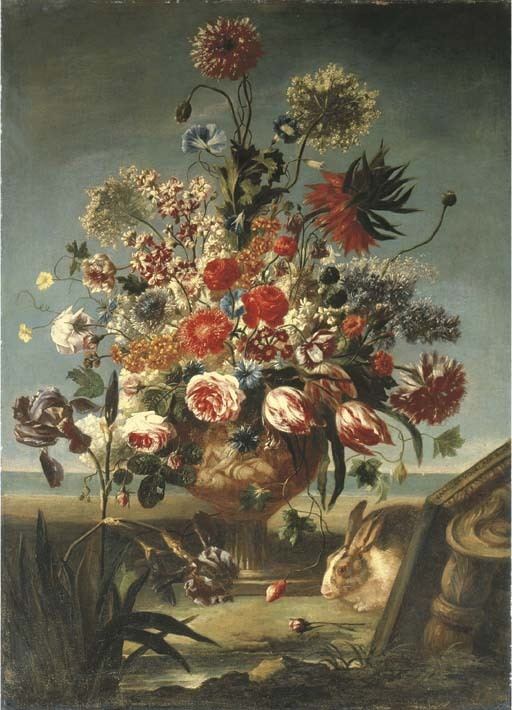Name Carel Vogelaer | Died August 8, 1695 | |
 | ||
Artwork Flowers in a Glass Bottle, Garland with Flora, A Wreath of Flowers, Stilleben med villebrad, Rosor i urna, Nejlikor i urna | ||
'Karel van Vogelaer or Carel de Vogelaer or Distelbloem' (1653 - 8. August 1695) was a netherland still life painter of the Baroque period primarily active in Italy where he was known as 'Carlo dei Fiori'.
Contents
Biography
Vogelaer was born in Maastricht, his father was Pieter de Vogelaer and also an artist. 1668 he started to travel through France, then about 1671 he moved to Rome (first mentioned 1675 in the Bentveughels (society of artists) where they gave him the nickname 'Distel-Blum', means "thistle Flower" and shared a house with fellow Flemish painter Anthoni Schoonjans in the Via Margutta. He trained or worked in the studio of Carlo Maratti, who became famous because of his huge floral still lifes. This influenced him a lot in his paintings. His permanent presence for Rome is declared from 1683 on.
Vogelaer created many community works together with other well-known artists, like Carlo Maratti, Luigi Garzi, Giovanni Battista Gaulli, Antoni Schoonjans und Filippo Lauri, with whom he were friend too, and best with Mario Nuzzi (called 'Mario de' Fiori').
About his work
According to Pascoli, he enjoyed immediate success there and was patronised by many of Rome's affluent collectors such as Francesco Montioni, Marchese Niccolò Maria Pallavicini, the Abate Paolucci, and Giambattista Cefalassi. But his best friends were Luigi Garzi, Gaulli and Maratta, later Franz Werner Tamm from Hamburg, with whom he appreciated most to collaborate. It is said, that he also got orders from Arcangelo Corelli and the Contestabile Colonna.
Another nickname in Italy was Carlo de' Fiori or Carlo dei Fiori for his paintings of still life themes such as flowers, fruits or game; other sources call him Carlo Volgar or Carlo Vogel. He joined the Bentvueghels with the Netherland nickname of Distelbloem ("thistle flower"). In the age of 42 he already died in Rome.
Review
His numerous and loved still lifes have a high reputation as well today. The best proof for this declaration are the high price results at the well known auctions houses in europe. But not only this point is a fact. Much museums are proud to present works by the artists, as one can see originals in the houses of Den Haag, the National Museum in Stockholm, in Hannover, Vaduz (Collection Liechtenstein) and of course in Rome (Palazzo Colonna).
There you can study his delicacy and minutely detailed care in executing his arrangements of flowers by numerous types in form and colour, perfectly drawn and so precisely that you are trapped by the eye and you want to pick them up. Clearly defined outlines and bright colors in several sizes and set in a natural surrounding, hold by exactly painted vases or humble urns. This is a real joy of regarding.
